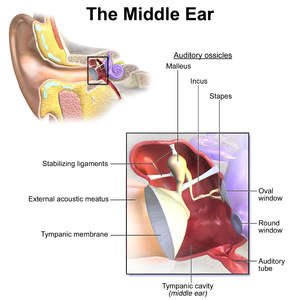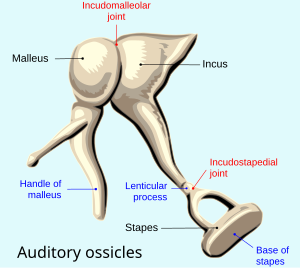Ossicles
The ossicles are the three smallest bones in the human body. They may be called ear bones or auditory ossicles. They are in the auditory system of all mammals.
| Ossicles | |
|---|---|
 | |
 | |
| Details | |
| Part of | Middle ear |
| Identifiers | |
| Latin | Ossicula auditus, ossicula auditoria |
| MeSH | D004429 |
| TA | A02.1.17.001 |
| FMA | 52750 |
| Anatomical terms of bone | |
They are contained within the middle ear space and serve to transmit sounds from the air to the fluid-filled labyrinth (cochlea). The absence of the auditory ossicles would cause moderate-to-severe deafness.
Anatomy
changeThe ossicles are, in order from the eardrum to the inner ear (from superficial to deep), the malleus, incus, and stapes. The terms mean hammer, anvil, and stirrup.
- The malleus (hammer) connects with the incus and is attached to the tympanic membrane (eardrum), from which vibrational sound pressure motion is passed.
- The incus (anvil) is connected to both the other bones.
- The stapes (stirrup) connects with the incus and is attached to the membrane of the fenestra ovalis, the elliptical or oval window or opening between the middle ear and the inner ear.
Development
changeStudies have shown that ear bones in mammal embryos are attached to the dentary, which is part of the lower jaw. These are ossified (turned into bone) portions of cartilage -- called Meckel's cartilage -- that are attached to the jaw. As the embryo develops, the cartilage hardens to form bone. Later in development, the bone structure breaks loose from the jaw and migrates to the inner ear area. The structure is known as the middle ear, and is made up of the incus, stapes, malleus, and tympanic membrane. These correspond to the quadrate, prearticular, articular, and angular structures in earlier land vertebrates.[1]
Related pages
changeReferences
change- ↑ Meng, Jin. 2003. The journey from jaw to ear. Biologist. 50. 154-158